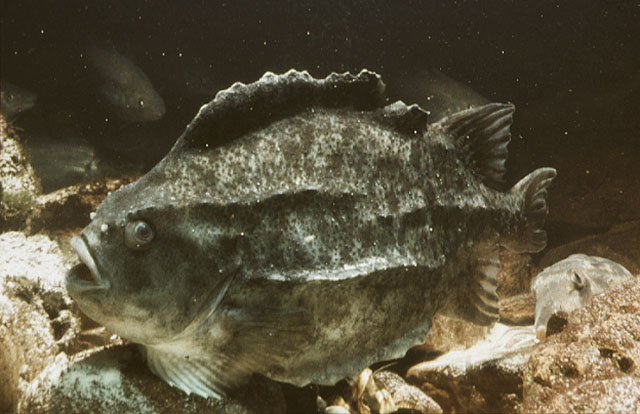| Cyclopteridae (Lumpfishes), subfamily: Cyclopterinae |
| 61 cm TL (male/unsexed); 42.9 cm SL (female); max.weight: 9,500.0 g; max.weight: 5,000.0 g; max. reported age: 13 years |
|
benthopelagic; marine; depth range 0 - 868 m, oceanodromous |
| Western Atlantic: Nunavut, Hudson Bay to James Bay and Labrador in Canada to New Jersey in USA; rarely to Chesapeake Bay in USA and Bermuda. Eastern Atlantic: Barents Sea, Iceland and Greenland to Spain (Ref. 4701). |
|
Dorsal spines (total): 5-9; Dorsal soft rays (total): 9-11; Anal spines: 0-0; Anal soft rays: 9-10; Vertebrae: 28-29. First dorsal fin present but covered by thick layer of skin forming a characteristic high crest with embedded spines. Bony tubercles present, arranged in 3 widely separated rows of large flattened tubercles on each side of body. Gill openings large, extend- extending below level of upper pectoral fin ray. Pyloric present 36-79. Ventral sucking disc formed by the modified pelvic fin (Ref. 232). |
| Basically solitary rather than a schooling fish. They exhibit a homing instinct (Ref. 9737). Adults inhabit rocky bottoms but may occur among floating seaweed. They migrate considerable distances in an annual cycle between deeper waters in winter and shallower waters in summer (Ref. 26141). Maximum depth reported at 868 m (Ref. 58426). Epibenthic-pelagic (Ref. 58426). Juveniles are found among algal clumps in bays and fjords moving offshore as they mature (Ref. 96431). During the spawning season the males become reddish in color on the underside, whereas females turn blue-green. Adults feed on ctenophores, medusas, small crustaceans, polychaetes, jelly fish and small fishes. Valued for their eggs, which make an inexpensive caviar (Ref. 9988). Eaten in Nordic countries, marketed fresh or smoked. Male flesh is most demanded and roe is sold fresh (Ref. 35388). |
|
Not Evaluated (N.E.) Ref. (130435)
|
| harmless |
|
Source and more info: www.fishbase.org. For personal, classroom, and other internal use only. Not for publication.

